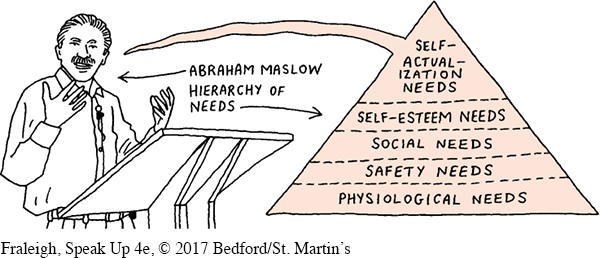Appealing to Your Audience’s Needs
Audience members have needs—objects they desire and feelings that must be satisfied. Human needs powerfully affect how we behave and how we respond to one another’s ideas. As we note in Chapter 5, your message is more likely to succeed when it is relevant to the audience—
According to Maslow’s hierarchy of needs, people’s most basic needs must be met before they will focus on less essential ones. The most basic human needs are physiological: we require food, drink, health, and shelter to survive. After these needs are met, we attend to safety needs, which include economic security and protection from danger. If our physiological and safety needs are fulfilled, we seek to satisfy social needs, including love and friendship. From there, we strive for self-
Page 516

You should consider this hierarchy when analyzing your audience. If most audience members are struggling to pay their rent, it will be difficult to persuade them to donate to a political campaign, eat organic food, or sign up for an elective class in pottery. These activities may be worthy, but they will not help students who are dealing with late fees or the threat of eviction. Ideas that cost money are likely to fall outside these audience members’ latitude of acceptance, potentially resulting in a boomerang effect.
By focusing on needs that are of concern to audience members, your speech will be more likely to persuade. For example, let’s say you want to give a speech convincing your classmates to exercise more often. Exercise fulfills a number of different needs: it can improve people’s health, help them perform better at work and in school, increase their self-